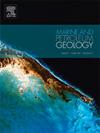长73页岩中黄铁矿形态及硫同位素特征:氧化还原条件及有机质和烃类富集指示
IF 3.7
2区 地球科学
Q1 GEOSCIENCES, MULTIDISCIPLINARY
引用次数: 0
摘要
鄂尔多斯盆地三叠系延长组长73亚段湖相富有机质烃源岩中富含页岩油。然而,对于Ch73亚段中黄铁矿与有机质和碳氢化合物的共存,目前还缺乏认识。本研究通过有机地球化学、元素地球化学、黄铁矿硫同位素(δ34Spy)和黄铁矿树状体尺寸分布等方面的研究,重建了底水氧化还原条件,阐明了其对有机质富集的影响以及黄铁矿在有机质和油气富集中的作用。基于黄铁矿的参数包括DOPM(矿物基黄铁矿化度,范围为0.53 ~ 1.00,平均为0.84)、菱形黄铁矿粒度分布(范围为1.10 ~ 31.54 μm,平均为8.80 μm)和δ34Spy(范围为- 0.5‰~ 6.1‰,平均为3.2‰),表明Ch73亚段沉积时底水氧化还原条件以缺氧-缺氧为主,常伴有缺氧-缺氧。氧化还原参数(黄铁矿的尺寸分布、δ34Spy、FeT/Al、DOPM以及U和Mo的富集因子)与总有机碳(TOC)含量之间具有良好的相关性,表明缺氧底水条件是Ch73亚段有机质富集的重要控制因素,尽管不是唯一的控制因素。此外,黄铁矿相关参数(草莓状黄铁矿尺寸分布和δ34Spy)与TOC、氯仿沥青“A”和Rock-Eval参数的相关性表明,草莓状黄铁矿直径较小,尺寸分布窄,δ34Spy值较低,表明有机质和油气富集,具有较大的成藏潜力。本文章由计算机程序翻译,如有差异,请以英文原文为准。
Morphology and sulfur isotopes of pyrite in Chang73 shale: Indications for redox conditions and enrichment of organic matter and hydrocarbons
Shale oil is abundant in lacustrine organic-rich source rocks within the Chang73 (Ch73) submember of the Triassic Yanchang Formation in the Ordos Basin, China. However, there remains a lack of understanding regarding the coexistence of pyrite with organic matter and hydrocarbons in the Ch73 submember. This study systematically investigates organic geochemistry, elemental geochemistry, pyrite sulfur isotopes (δ34Spy), and size distributions of pyrite framboids to reconstruct bottom-water redox conditions and elucidate its influence on organic matter enrichment and the role of pyrite in organic matter and hydrocarbon enrichment. Pyrite-based parameters, including DOPM proposed in this study (mineral-based degree of pyritization, ranging from 0.53 to 1.00 with an average of 0.84), size distributions of pyrite framboids (ranging from 1.10 μm to 31.54 μm with an average of 8.80 μm), and δ34Spy (ranging from −0.5 ‰ to 6.1 ‰ with an average of 3.2 ‰), indicate that the bottom-water redox conditions during deposition of the Ch73 submember were primarily dysoxic–oxic, frequently accompanied by anoxic–euxinic. Good correlations between redox parameters (pyrite framboids’ size distributions, δ34Spy, FeT/Al, DOPM, and enrichment factors of U and Mo) and total organic carbon (TOC) contents suggest that anoxic bottom-water conditions were a significant, although not exclusive, controlling factor for organic matter enrichment in the Ch73 submember. Moreover, correlations between pyrite-related parameters (pyrite framboids' size distributions and δ34Spy) and TOC, chloroform bitumen “A”, and Rock-Eval parameters, respectively, suggest that smaller diameter and narrow size distributions of pyrite framboids as well as low δ34Spy values indicate organic matter and hydrocarbon enrichment and great oil potential.
求助全文
通过发布文献求助,成功后即可免费获取论文全文。
去求助
来源期刊

Marine and Petroleum Geology
地学-地球科学综合
CiteScore
8.80
自引率
14.30%
发文量
475
审稿时长
63 days
期刊介绍:
Marine and Petroleum Geology is the pre-eminent international forum for the exchange of multidisciplinary concepts, interpretations and techniques for all concerned with marine and petroleum geology in industry, government and academia. Rapid bimonthly publication allows early communications of papers or short communications to the geoscience community.
Marine and Petroleum Geology is essential reading for geologists, geophysicists and explorationists in industry, government and academia working in the following areas: marine geology; basin analysis and evaluation; organic geochemistry; reserve/resource estimation; seismic stratigraphy; thermal models of basic evolution; sedimentary geology; continental margins; geophysical interpretation; structural geology/tectonics; formation evaluation techniques; well logging.
 求助内容:
求助内容: 应助结果提醒方式:
应助结果提醒方式:


